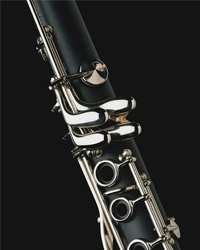instrument: Clarinet
 The clarinet is a single-reed wind instrument, with a closed cylindrical tube, and with historical ties to a variety of single-tube wind instruments of a pastoral nature used across Europe and elsewhere, going back centuries. The clarinet comes in a wide mix of sizes and keys – from contrabass to piccolo, as well as the basset horn – though within classical music only a few are commonly employed today: the standard or soprano clarinet (in Bb or A), the higher sopranino clarinet (in Eb or D), and the bass clarinet (in Bb). The “modern” clarinet has its roots in the early 18th century, generally attributed to Johann Christoph Denner of Nuremberg, and henceforth underwent a complex set of modifications, culminating in the so-called Boehm clarinet (named inaccurately after the flute-maker, Theobald Boehm) in the 1840s – which is largely the structure used today.
The clarinet is a single-reed wind instrument, with a closed cylindrical tube, and with historical ties to a variety of single-tube wind instruments of a pastoral nature used across Europe and elsewhere, going back centuries. The clarinet comes in a wide mix of sizes and keys – from contrabass to piccolo, as well as the basset horn – though within classical music only a few are commonly employed today: the standard or soprano clarinet (in Bb or A), the higher sopranino clarinet (in Eb or D), and the bass clarinet (in Bb). The “modern” clarinet has its roots in the early 18th century, generally attributed to Johann Christoph Denner of Nuremberg, and henceforth underwent a complex set of modifications, culminating in the so-called Boehm clarinet (named inaccurately after the flute-maker, Theobald Boehm) in the 1840s – which is largely the structure used today.
Given its novelty in the first half of the 18th century, few composers of the late Baroque employed the clarinet, with minor exceptions in a handful of obscure works by George Frideric Handel and Jean-Philippe Rameau, among others. The first serious interest arose among composers of the so-called Mannheim school (early Classical era), especially Johann Stamitz – who wrote one of the first clarinet concertos. By the 1780s, the clarinet had become fairly common in orchestras across Europe, where it became a favorite, for example, of Wolfgang Amadeus Mozart – notably in his ‘Kegelstatt’ Trio, K.498, the Clarinet Quintet, K.581, and the Clarinet Concerto, K.622; indeed, Mozart’s approach toward clarinet writing – full and beautiful over its full range – had an impact on its usage that remains to this day.
The technical improvements made on the clarinet during the early Romantic era were then reflected in clarinet-featured works by composers such as Carl Maria von Weber and Felix Mendelssohn, as well as in its now standard use in the orchestral works of Ludwig van Beethoven, Franz Schubert, and beyond – where it increasingly became associated with romantic, expressive writing. At the same time, composers such as Hector Berlioz began to explore the more unusual colors made possible by the clarinet - such as in his Symphonie fantastique. Such trends were continued in the imaginative orchestrations of composers such as Richard Wagner, Antonín Dvořák, Gustav Mahler, Richard Strauss – and later Igor Stravinsky, Alban Berg, and others. In the early 20th century, the clarinet was singled out in its association with jazz, as seen in works such as George Gershwin’s Rhapsody in Blue, Stravinsky’s Ebony Concerto, and Leonard Bernstein’s Prelude, Fugue, and Riffs – the latter two written for Benny Goodman. As they have with most other instruments, composers of the Modern and Contemporary periods have frequently pursued avenues to exploit the clarinet’s virtuosity, as well as to explore the unusual sounds it can produce – such as quarter-tones and multi-phonics (producing 2 or more notes at once).

Nolan Gasser, PhD
Artistic Director













